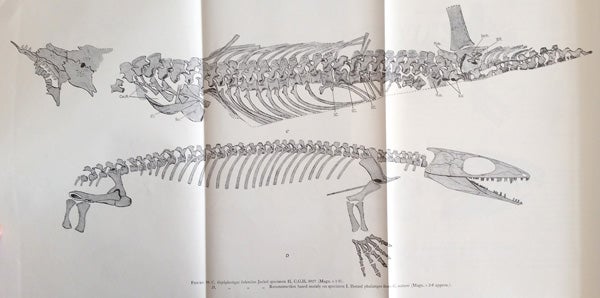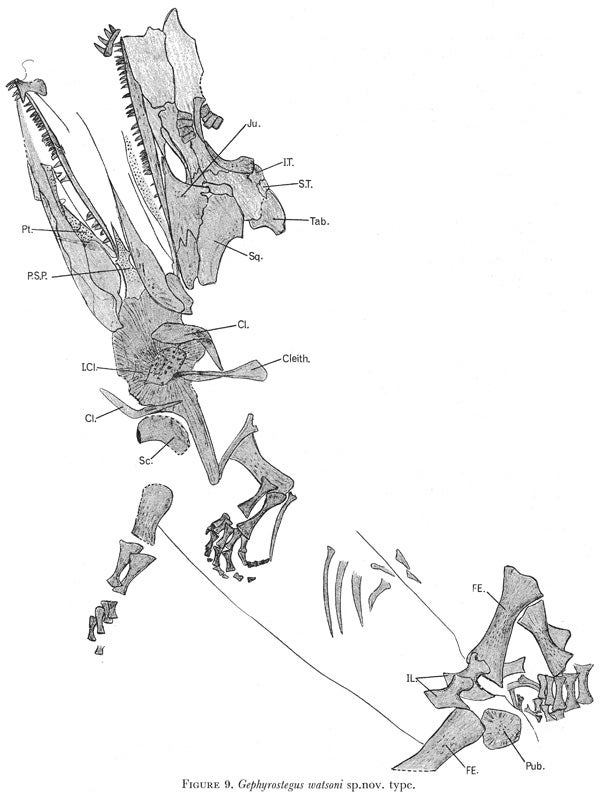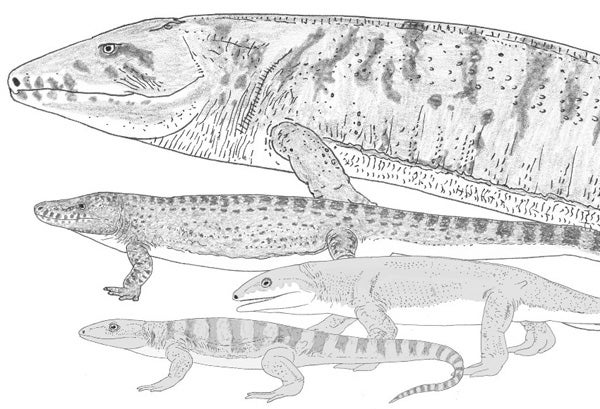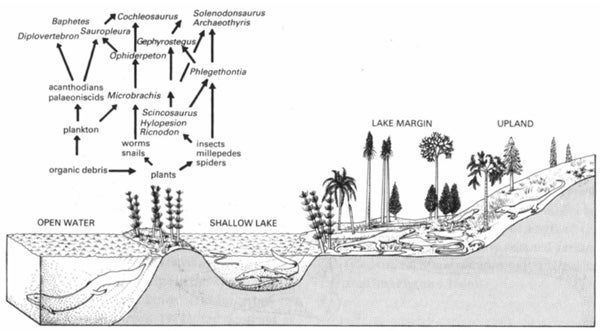This article was published in Scientific American’s former blog network and reflects the views of the author, not necessarily those of Scientific American
It might not be a secret round these parts that I’m working on a textbook about the whole of vertebrate history. Yes, vertebrate history, not just tetrapod history. It’s a consequence of this substantial project that I’m gradually compiling text and illustrations on all the vertebrate groups. Early tetrapods – non-amniotes or anamniotes – have never been especially well represented here at Tet Zoo, though I’ve at least made a bit of an effort to write about temnospondyls on occasion (see links below).
With this in mind, and for no special reason at all, today we look at the Carboniferous anamniote Gephyrostegus [skull reconstruction above from Klembara et al. (2014)]. The text here is an abridged and modified version of the gephyrostegid section included within said book.

Brough & Brough (1967) produced this nice large foldout of a specimen they referred to Gephyrostegus. Alas, the fossils shown here are no longer thought to belong to this animal (read on).
On supporting science journalism
If you're enjoying this article, consider supporting our award-winning journalism by subscribing. By purchasing a subscription you are helping to ensure the future of impactful stories about the discoveries and ideas shaping our world today.
Gephyrostegus bohemicus, originally named in 1902, is a mid-sized (approximately 25 cm long) anamniote from the famous Nýrany site in the Czech Republic [Nýrany is actually written with a hacek on the r, but I can’t get this to work on the Sci Am publishing platform]. Several good, articulated specimens are known and experts have differed as to how the remains might best be reconstructed. The images used here come from Margaret and James Brough’s 1967 monograph on this animal (Brough & Brough 1967) (incidentally, political reasons required that the publication of this monograph had to be delayed for more than two decades). These authors recognised a second, smaller species (G. watsoni) though most recent authors have regarded this as a junior synonym of G. bohemicus. Also worth noting is that some of the fossils identified by Brough & Brough (1967) as Gephyrostegus specimens later turned out to be wholly different animals: one became the holotype of the reptile Brouffia, another is now the holotype of the reptile Coelostegus.

The Gephyrostegus watsoni holotype, from Brough & Brough (1967). They didn't provide a scalebar. G. watsoni is now regarded as a synonym of G. bohemicus.
What sort of animal is Gephyrostegus? Brough & Brough (1967) favoured a position within Seymouriamorpha (an anamniote group traditionally – but perhaps erroneously – considered close to the origin of amniotes). Subsequent to their study, it mostly became regarded as part of Anthracosauria (Smithson 1986, Laurin 1998, Paton et al. 1999, Clack 2002), or at least in the same general region of the tree. More recently, several phylogenetic analyses have found Gephyrostegus closer to amniotes than are ‘core anthracosaurs’ like the embolomeres (Ruta et al. 2003a, b, Clack & Finney 2005, Clack & Klembara 2009, Danto et al. 2012, Klembara et al. 2014), and perhaps with a sister-group relationship to seymouriamorphs (Klembara et al. 2014).

One possible topology for 'anthracosaur-grade' anamniotes, showing Gephyrostegus as closer to amniotes than embolomeres (this is a segment of a much larger cladogram). The hypothesis shown here is mostly based on Ruta et al. (2003a, b). The positions of Seymouriamorpha, Westlothiana and some of these other groups and taxa move around from one study to the next. These images and many others from the Tet Zoo patreon.
And if you want to know more about anthracosaurs… sorry, I just can’t discuss anthracosaurs here, whatever we mean by this term (ugh, such a mess). I will say that it’s the anamniote group that includes the mostly very large, long-bodied, highly aquatic embolomeres and taxa of similar grade. Anyway, within recent decades there’s been a tendency to recognise a higher group – Gephyrostegida – for the lineage that includes Gephyrostegus, though this is a redundant name in phylogenetic terms given the existence of the name Gephyrostegidae. Additional taxa sometimes included within Gephyrostegidae are Bruktererpeton from Germany and Eusauropleura from the USA. Another anamniote from Nýrany – Solenodonsaurus – has been considered synonymous with Gephyrostegus by some authors but this is almost certainly not correct.

A select few 'anthracosaur-grade' anamniotes. The big animal at the back is the embolomere Proterogyrinus from Scotland and the USA. Closest to it is Solenodonsaurus from the Czech Republic; front right is Eldeceeon from Scotland, and front left is Gephyrostegus. Image by Darren Naish, produced for that big book project.
In proportions and body shape, Gephyrostegus is superficially seymouriamorph-like as well as amniote-like and, accordingly, it was once imagined as being close to the ancestry of reptiles. A well ossified ankle suggests specialisation for terrestrial life, and large orbits, numerous small pointed teeth and a small body size are consistent with an insectivorous or faunivorous lifestyle spent on land. A famous and much-reproduced diagram depicting a possible foodweb at Nýrany shows Gephyrostegus as a terrestrial predator that might have eaten aistopods, microsaurs and nectrideans. I suppose a diet of small vertebrates is just about plausible, but they’d have to be very small ones. Indeed, with a total length of less than 30 cm, Gephyrostegus is among the smallest of taxa within the relevant part of the tree.

That Nýrany foodweb diagram. This version is from Benton's 2004 Vertebrate Palaeontology... I think the original appears in a 1980 paper by Andrew Milner (there's a giant, two-page version in Halstead's 1982 Hunting the Past). Gephyrostegus appears on land, directly beneath the words 'lake margin'.
And there we have it. I will cover other anamniote groups in time. And here’s another reminder that this text mostly comes from my textbook project.
For previous Tet Zoo articles on fossil anamniotes, see...
Further temnospondyl adventures: it’s mostly about the dissorophoids (or some of them anyway)
Trematosauroids, those gharial-snouted, marine temnospondyls
Trimerorhachid temnospondyls: numerous scale layers and… gill-pouch brooding?
More temnospondyls: gigantic, gharial-snouted archegosauroids and their spatulate-snouted kin
The troubling lack of Platyhystrix images online: the Tet Zoo Solution
Refs - -
Brough, M. C. & Brough, J. 1967. Studies on early tetrapods. I. The Lower Carboniferous microsaurs. II. Microbrachis, the type microsaur. III. The genus Gephyrostegus. Philosophical Transactions of the Royal Society of London B 252, 107-165.
Clack, J. A. 2002. Gaining Ground: The Origin and Evolution of Tetrapods. Indiana University Press, Bloomington and Indianapolis.
Clack, J. A. & Finney, S. M. 2005. Pederpes finneyae, an articulated tetrapod from the Tornaisian of Western Scotland. Journal of Systematic Palaeontology 2, 311-346.
Clack, J. A. & Klembara, J. 2009. An articulated specimen of Chroniosaurus dongusensis, and the morphology and relationships of the chroniosuchids. Special Papers in Palaeontology 81, 15-42.
Danto, M., Witzmann, F. & Muller, J. 2012. Redescription and phylogenetic relationships of Solenodonsaurus janenschi Broili, 1924, from the Late Carboniferous of Ny ´rˇany, Czech Republic. Fossil Record 15, 45-59.
Klembara, J., Clack, J. A., Milner, A. R. & Ruta, M. 2014. Cranial anatomy, ontogeny, and relationships of the Late Carboniferous tetrapod Gephyrostegus bohemicus Jaekel, 1902. Journal of Vertebrate Paleontology 34, 774-792.
Laurin, M. 1998. The importance of global parsimony and historical bias in understanding tetrapod evolution. Part I. Systematics, middle ear evolution and jaw suspsension. Annales des Sciences Naturelles 1, 1-42.
Paton, R. L., Smithson, T. R. & Clack, J. A. 1999. An amniote-like skeleton from the Early Carboniferous of Scotland. Nature 398, 508-513.
Ruta, M., Coates, M. I. & Quicke, D. L. J. 2003a. Early tetrapod relationships revisited. Biological Reviews 78, 251-345.
Ruta, M., Jeffery, J. & Coates, M. I. 2003b. A supertree of early tetrapods. Proceedings of the Royal Society of London B 270, 2507-2516.
Smithson, T. R. 1986. A new anthracosaur amphibian from the Carboniferous of Scotland. Palaeontology 29, 603-628.